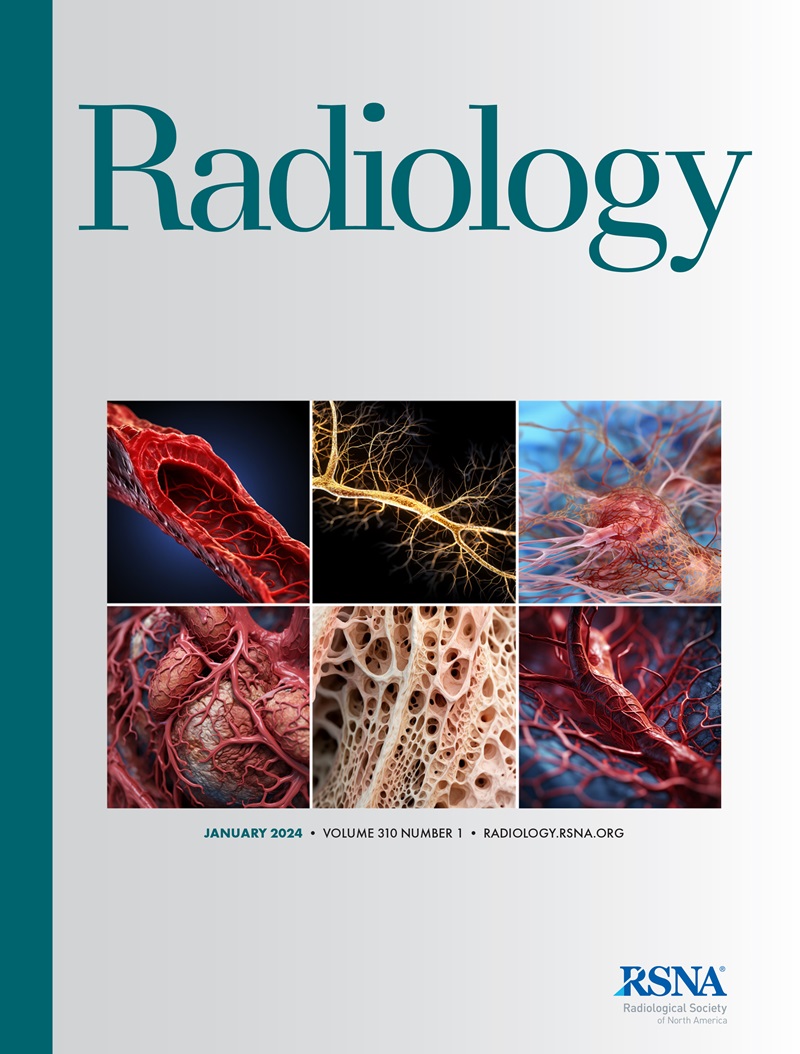下载PDF
{"title":"磁共振成像预测直肠癌患者的残留病灶和预后","authors":"Hannah Williams, Dana M Omer, Hannah M Thompson, Sabrina T Lin, Floris S Verheij, Joao Miranda, Jonathan B Yuval, James Buckley, Michael R Marco, Li-Xuan Qin, David A Dombroski, Rajendra Kedar, Aytekin Oto, Elena Korngold, Joseph C Veniero, Sunil Gandhi, Arun Krishnaraj, Minal Jagtiani, Kirk Ohanian, Dan Vu, Thomas A Hope, Sonia Lee, Ashish P Wasnik, Nikhil Madhuripan, Marc J Gollub, Julio Garcia-Aguilar","doi":"10.1148/radiol.232748","DOIUrl":null,"url":null,"abstract":"<p><p>Background MRI plays a crucial role in restaging locally advanced rectal cancer treated with total neoadjuvant therapy (TNT); however, prospective studies have not evaluated its ability to accurately select patients for nonoperative management. Purpose To evaluate the ability of restaging MRI to predict oncologic outcomes and identify imaging features associated with residual disease (RD) after TNT. Materials and Methods This was a secondary analysis of the Organ Preservation in Rectal Adenocarcinoma (OPRA) trial, which randomized participants from April 2014 to March 2020 with stages II or III rectal adenocarcinoma to undergo either induction or consolidation TNT. Participants enrolled in the OPRA trial who underwent restaging MRI were eligible for inclusion in the present study. Radiologists classified participants as having clinical complete response (cCR), near-complete clinical response (nCR), or incomplete clinical response (iCR) based on restaging MRI at a mean of 8 weeks ± 4 (SD) after treatment. Oncologic outcomes according to MRI response category were assessed using Kaplan-Meier curves. Logistic regression analysis was performed to identify imaging characteristics associated with RD. Results A total of 277 participants (median age, 58 years [IQR, 17 years]; 179 male) who were randomized in the OPRA trial had restaging MRI forms completed. The median follow-up duration was 4.1 years. Participants with cCR had higher rates of organ preservation compared with those with nCR (65.3% vs 41.6%, log-rank <i>P</i> < .001). Five-year disease-free survival for participants with cCR, nCR, and iCR was 81.8%, 67.6%, and 49.6%, respectively (log-rank <i>P</i> < .001). The MRI response category also predicted overall survival (log-rank <i>P</i> < .001), distant recurrence-free survival (log-rank <i>P</i> = .005), and local regrowth (log-rank <i>P</i> = .02). Among the 266 participants with at least 2 years of follow-up, 129 (48.5%) had RD. At multivariable analysis, the presence of restricted diffusion (odds ratio, 2.50; 95% CI: 1.22, 5.24) and abnormal nodal morphologic features (odds ratio, 5.04; 95% CI: 1.43, 23.9) remained independently associated with RD. Conclusion The MRI response category was predictive of organ preservation and survival. Restricted diffusion and abnormal nodal morphologic features on restaging MRI scans were associated with increased likelihood of residual tumor. ClinicalTrials.gov identifier: NCT02008656 © RSNA, 2024 <i>Supplemental material is available for this article.</i> See also the editorial by Milot in this issue.</p>","PeriodicalId":20896,"journal":{"name":"Radiology","volume":null,"pages":null},"PeriodicalIF":12.1000,"publicationDate":"2024-09-01","publicationTypes":"Journal Article","fieldsOfStudy":null,"isOpenAccess":false,"openAccessPdf":"https://www.ncbi.nlm.nih.gov/pmc/articles/PMC11427875/pdf/","citationCount":"0","resultStr":"{\"title\":\"MRI Predicts Residual Disease and Outcomes in Watch-and-Wait Patients with Rectal Cancer.\",\"authors\":\"Hannah Williams, Dana M Omer, Hannah M Thompson, Sabrina T Lin, Floris S Verheij, Joao Miranda, Jonathan B Yuval, James Buckley, Michael R Marco, Li-Xuan Qin, David A Dombroski, Rajendra Kedar, Aytekin Oto, Elena Korngold, Joseph C Veniero, Sunil Gandhi, Arun Krishnaraj, Minal Jagtiani, Kirk Ohanian, Dan Vu, Thomas A Hope, Sonia Lee, Ashish P Wasnik, Nikhil Madhuripan, Marc J Gollub, Julio Garcia-Aguilar\",\"doi\":\"10.1148/radiol.232748\",\"DOIUrl\":null,\"url\":null,\"abstract\":\"<p><p>Background MRI plays a crucial role in restaging locally advanced rectal cancer treated with total neoadjuvant therapy (TNT); however, prospective studies have not evaluated its ability to accurately select patients for nonoperative management. Purpose To evaluate the ability of restaging MRI to predict oncologic outcomes and identify imaging features associated with residual disease (RD) after TNT. Materials and Methods This was a secondary analysis of the Organ Preservation in Rectal Adenocarcinoma (OPRA) trial, which randomized participants from April 2014 to March 2020 with stages II or III rectal adenocarcinoma to undergo either induction or consolidation TNT. Participants enrolled in the OPRA trial who underwent restaging MRI were eligible for inclusion in the present study. Radiologists classified participants as having clinical complete response (cCR), near-complete clinical response (nCR), or incomplete clinical response (iCR) based on restaging MRI at a mean of 8 weeks ± 4 (SD) after treatment. Oncologic outcomes according to MRI response category were assessed using Kaplan-Meier curves. Logistic regression analysis was performed to identify imaging characteristics associated with RD. Results A total of 277 participants (median age, 58 years [IQR, 17 years]; 179 male) who were randomized in the OPRA trial had restaging MRI forms completed. The median follow-up duration was 4.1 years. Participants with cCR had higher rates of organ preservation compared with those with nCR (65.3% vs 41.6%, log-rank <i>P</i> < .001). Five-year disease-free survival for participants with cCR, nCR, and iCR was 81.8%, 67.6%, and 49.6%, respectively (log-rank <i>P</i> < .001). The MRI response category also predicted overall survival (log-rank <i>P</i> < .001), distant recurrence-free survival (log-rank <i>P</i> = .005), and local regrowth (log-rank <i>P</i> = .02). Among the 266 participants with at least 2 years of follow-up, 129 (48.5%) had RD. At multivariable analysis, the presence of restricted diffusion (odds ratio, 2.50; 95% CI: 1.22, 5.24) and abnormal nodal morphologic features (odds ratio, 5.04; 95% CI: 1.43, 23.9) remained independently associated with RD. Conclusion The MRI response category was predictive of organ preservation and survival. Restricted diffusion and abnormal nodal morphologic features on restaging MRI scans were associated with increased likelihood of residual tumor. ClinicalTrials.gov identifier: NCT02008656 © RSNA, 2024 <i>Supplemental material is available for this article.</i> See also the editorial by Milot in this issue.</p>\",\"PeriodicalId\":20896,\"journal\":{\"name\":\"Radiology\",\"volume\":null,\"pages\":null},\"PeriodicalIF\":12.1000,\"publicationDate\":\"2024-09-01\",\"publicationTypes\":\"Journal Article\",\"fieldsOfStudy\":null,\"isOpenAccess\":false,\"openAccessPdf\":\"https://www.ncbi.nlm.nih.gov/pmc/articles/PMC11427875/pdf/\",\"citationCount\":\"0\",\"resultStr\":null,\"platform\":\"Semanticscholar\",\"paperid\":null,\"PeriodicalName\":\"Radiology\",\"FirstCategoryId\":\"3\",\"ListUrlMain\":\"https://doi.org/10.1148/radiol.232748\",\"RegionNum\":1,\"RegionCategory\":\"医学\",\"ArticlePicture\":[],\"TitleCN\":null,\"AbstractTextCN\":null,\"PMCID\":null,\"EPubDate\":\"\",\"PubModel\":\"\",\"JCR\":\"Q1\",\"JCRName\":\"RADIOLOGY, NUCLEAR MEDICINE & MEDICAL IMAGING\",\"Score\":null,\"Total\":0}","platform":"Semanticscholar","paperid":null,"PeriodicalName":"Radiology","FirstCategoryId":"3","ListUrlMain":"https://doi.org/10.1148/radiol.232748","RegionNum":1,"RegionCategory":"医学","ArticlePicture":[],"TitleCN":null,"AbstractTextCN":null,"PMCID":null,"EPubDate":"","PubModel":"","JCR":"Q1","JCRName":"RADIOLOGY, NUCLEAR MEDICINE & MEDICAL IMAGING","Score":null,"Total":0}
引用次数: 0
引用
批量引用


